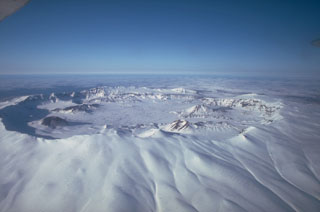Report on Okmok (United States) — January 1997
Bulletin of the Global Volcanism Network, vol. 22, no. 1 (January 1997)
Managing Editor: Richard Wunderman.
Okmok (United States) Eruption begins on 13 February from crater along S caldera rim
Please cite this report as:
Global Volcanism Program, 1997. Report on Okmok (United States) (Wunderman, R., ed.). Bulletin of the Global Volcanism Network, 22:1. Smithsonian Institution. https://doi.org/10.5479/si.GVP.BGVN199701-311290
Okmok
United States
53.43°N, 168.13°W; summit elev. 1073 m
All times are local (unless otherwise noted)
On the morning of 13 February, a small eruption began from a cone at 760 m elevation along the S rim of the Okmok caldera. Around 1000 a dark ash plume rose to ~1,525 m and was carried SW by prevailing winds. On 18 February, Coast Guard pilots reported an ash plume that rose to an altitude of 3,050-4,600 m. Observers at the former Fort Glenn military base reported seeing a bright red glare reflected from the 1,830-m-high weather clouds between 0100 and sunrise. At 1335 pilots reported a second plume that rose to 4,875 m. Satellite imagery continued to reveal a hot spot in the vicinity of the cone through the week of 21 February.
Geological Summary. The broad, basaltic Okmok shield volcano, which forms the NE end of Umnak Island, has a dramatically different profile than most other Aleutian volcanoes. The summit of the low, 35-km-wide volcano is cut by two overlapping 10-km-wide calderas formed during eruptions about 12,000 and 2050 years ago that produced dacitic pyroclastic flows that reached the coast. More than 60 tephra layers from Okmok have been found overlying the 12,000-year-old caldera-forming tephra layer. Numerous satellitic cones and lava domes dot the flanks of the volcano down to the coast, including 1253-m Mount Tulik on the SE flank, which is almost 200 m higher than the caldera rim. Some of the post-caldera cones show evidence of wave-cut lake terraces; the more recent cones, some of which have been active historically, were formed after the caldera lake, once 150 m deep, disappeared. Hot springs and fumaroles are found within the caldera. Historical eruptions have occurred since 1805 from cinder cones within the caldera.
Information Contacts: Alaska Volcano Observatory (AVO); NOAA/NESDIS Satellite Analysis Branch (SAB).

